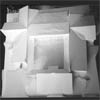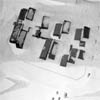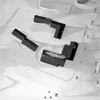ENVIRONMENTALLY AWARE DESIGN METHOD
To be able to design in accordance with the principles of sustainable development we have developed a method (CASE method) that includes an analysis of the environment and techniques for interpreting observations, equipment for wind testing of scale models and practical solutions.
ENVIRONMENTAL ANALYSES
During the analysis phase we create a description of the environment, which gives us enough information of the built environment of the target area, as well as of the natural environment, climate, environmental impacts and the townscape. Fieldwork is important here. The outputs are descriptions of habitat types, specification of building and green belts, recommended actions and design guidelines. The townscape analysis can be used as the basis for managing environmental quality goals and creating a management system for designing and implementation, if desired.
Improving the microclimate of a built environment often requires wind tunnel testing of scale models, which is presently costly and difficult. The wind testing equipment we have developed is portable, inexpensive and easy to use. An air-flow is directed at the model, and by studying the movements of indicators, we can see windy and calm areas, turbulence, and conclude how the microclimate should be developed.
UTILIZATION AND SIGNIFICANCE OF THE METHOD
The method can be used for community planning as well as building design. In town planning the method makes it possible design urban areas and blocks to achieve a positive microclimate. In environmental construction there are many areas, such as playgrounds, bus stops, sun terraces and small marinas, where it is necessary to control wind and the microclimate. By designing wind channels it is possible to ventilate exhaust gases and other air pollution.
The method can be used to support natural ventilation of buildings. Structures that are better protected from snow, slanting rain and sand stay in better condition and last longer. The energy consumption of buildings can be reduced by 5-10 percent with blocks and building shapes that shield against the wind. Passive utilisation of the sun enables another 5-10 percent energy saving.
Preparing for a climate change will spare us from many disasters and repair work in the future.







